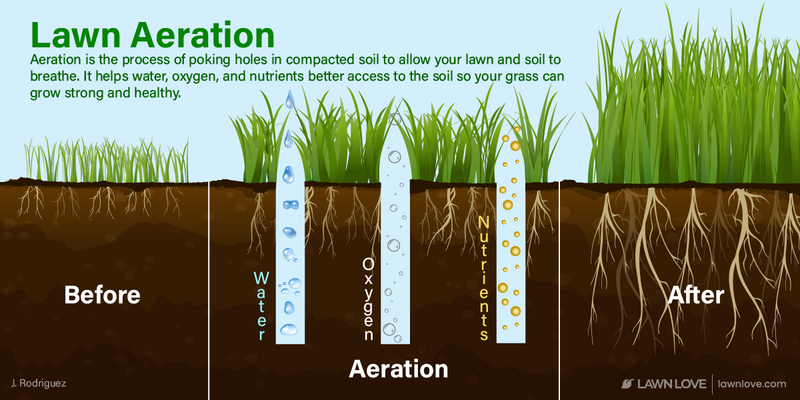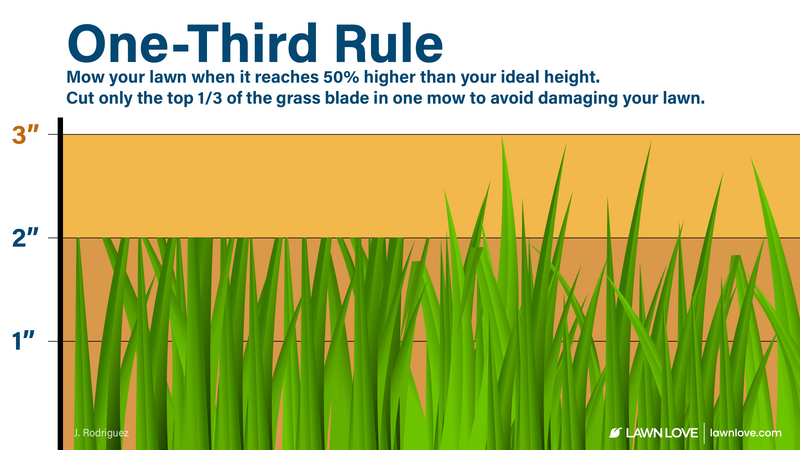
Year-round beautiful weather makes the area of Greensboro, Winston-Salem, High Point, and the surrounding cities one of the best places to live in the United States. Mild weather also makes lawn care easier for Piedmont Triad homeowners than for those in more extreme climates.
Still, if you want a thick and healthy lawn, you’ll have to put in the work. Starting off in spring with proper maintenance will set your lawn on the right track for the rest of the year, too. These spring lawn care tips for the Piedmont Triad are the most important things you can do for your lawn as the weather starts to warm up after winter.
- 1. Prepare lawn equipment at the beginning of spring
- 2. Dethatch grass during its growing season
- 3. Aerate annually
- 4. Prevent weeds with pre-emergent herbicides
- 5. Overseed warm-season grass
- 6. Fertilize for lush growth
- 7. Wait to water
- 8. Mow smart
- 9. Control spring lawn pests
- 10. Treat spring lawn diseases
- Start the year right with spring lawn care
1. Prepare lawn equipment at the beginning of spring
With spring comes new life and new growth for your grass, trees, and bushes — and weeds. That means you’ll be getting a lot of use out of your lawn care and landscaping equipment for the next several months, from lawn mowers to weed eaters to hedge trimmers to pruning shears.
Before you start using your tools on a regular basis again, help them wake up from their long winter nap by following this checklist:
- Inspect all tools for rust or damage
- Sharpen the blades on your lawn mower and shears
- Check your mower’s spark plug and oil filter and change them if necessary
- Refill the line in your weed eater
- Restock your supply of gas for gas-powered tools
- Make sure batteries for electric tools still hold a charge
2. Dethatch grass during its growing season

Over the course of the year, little bits of dead grass build up in the lawn between the living grass and the soil. This layer of debris is called thatch, and it should never be more than half an inch thick. If your thatch is thicker than that, you need to dethatch your lawn to remove the layer.
The best time to dethatch grass is during its growing season, which varies depending on your grass type. You might have cool-season or warm-season grass, since the Piedmont Triad is in the transition zone where both types grow.
Dethatch cool-season grasses at the beginning of their growing seasons in early spring (March-April) or early fall (September-October). Fescues, Kentucky bluegrass, and perennial ryegrass are common cool-season grasses in the Piedmont region of North Carolina.
Dethatch warm-season grasses at the beginning of their growing season in late spring to early summer (May-June). Bermudagrass, carpetgrass, centipedegrass, St. Augustinegrass, and Zoysiagrass are warm-season grasses common in this area.
3. Aerate annually

After dethatching is a good time to aerate your lawn. Aeration is the process of poking holes in compacted soil to loosen it up and give grass roots better access to water and plant nutrients. Prevent soil compaction and a lackluster lawn by aerating once every year.
As with dethatching, the best time to aerate your lawn depends on your grass type.
Aerate cool-season grasses during their early spring growth period if the soil is compacted and the grass is suffering, but wait until the fall growth period if possible. In fall, weeds are less likely to germinate in the holes left behind by aeration.
Aerate warm-season grasses in late spring (May-June) at the beginning of the grass’s growing season. Aerating in summer, when temperatures are much hotter, could cause too much stress and hurt your grass more than it helps.
4. Prevent weeds with pre-emergent herbicides
Springtime is when summer annual weeds and some perennial weeds germinate. If you don’t want a lawn full of weeds later in the year, apply pre-emergent herbicides in early spring (March-April) to nip weeds in the bud before they have a chance to sprout.
Pre-emergent herbicides are only effective for weeds that haven’t sprouted yet. If there are already weeds growing in your lawn in spring, you’ll have to apply post-emergent herbicides to get rid of them.
Identify the weeds in your yard with this list of common North Carolina turfgrass weeds from North Carolina State University to find the best way to kill and prevent them in the future.
Warning: If you plan to overseed your lawn this spring, do not spread herbicides, lest they kill the new grass seed along with the weeds.
5. Overseed warm-season grass
Grass that has become thin or patchy could benefit from overseeding, which means spreading new grass seed on top of your existing lawn to fill in gaps. Overseeding will repair bare patches and make your grass thicker.
Once again, the best time to overseed your lawn depends on your grass type’s growing season. Go ahead and overseed warm-season lawns in late spring (May-June), but hold off on cool-season lawns until early fall (September-October).
6. Fertilize for lush growth
For cool-season and warm-season lawns, you should fertilize at least three times per year for optimal growth. Both grass types benefit greatly from a feeding in early spring once growth resumes after winter (usually in mid- to late April in the Piedmont Triad area).
Before you fertilize your lawn, test your soil to find out what nutrients it’s lacking. This will help you choose the most beneficial type of fertilizer for your specific lawn. The North Carolina Department of Agriculture and Consumer Services offers free soil testing for all NC residents.
Once you know which fertilizer to use, follow the fertilization schedule in the chart below, depending on your grass type.
Cool-season (i.e. fescues, Kentucky bluegrass, perennial ryegrass):
- First feeding – April
- Second feeding – September
- Third feeding – November
Warm-season (i.e. bermudagrass, carpetgrass, centipedegrass, St. Augustinegrass, Zoysiagrass):
- First feeding – April
- Second feeding – June
- Third feeding – September
7. Wait to water
As soon as your grass greens up after winter, you might be tempted to start watering it again — but wait. Your soil may still be holding on to some moisture from winter, and overwatering can lead to lawn diseases and pests.
There’s no exact date when you should start watering your lawn in spring. Just pay attention to your grass and wait for it to show signs of drought stress, including:
- Wilting
- Fading color
- Footprints remaining visible in the lawn after you walk through it
When you notice these signs, you’re clear to resume your lawn’s regular watering schedule. Don’t worry about the drought stress, as your lawn will quickly “spring” back to normal as soon as you water it.
How much and how often to water your grass, once you start, depends on your grass type and soil type. A general rule of thumb is to start with 1 inch per week (including rainfall) and adjust as needed from there.
8. Mow smart
Don’t mow your lawn haphazardly. Mowing on the right schedule and at the right height for your grass type can do wonders for your lawn’s health, just as mowing incorrectly can lead to problems.
As with watering, there’s no specific time when you should mow your lawn for the first time in spring. Once your grass starts growing for the year around April, let it reach about 3 inches in height before the first mow.
When you start mowing, mow the lawn about once a week to keep your grass at its recommended height. The table below shows the best heights for some of the most common grass types for the Piedmont Triad.
| Common grass types for the Piedmont Triad | Recommended mowing height |
| Bermudagrass | 1 – 2 inches |
| Carpetgrass | 1.5 – 2 inches |
| Centipedegrass | 1 – 2 inches |
| Fine fescue | 1.5 – 4 inches |
| Kentucky bluegrass | 1.5 – 2.5 inches |
| Perennial ryegrass | 1.5 – 2.5 inches |
| St. Augustinegrass | 2.5 – 4 inches |
| Tall fescue | 3 – 3.5 inches |
| Zoysiagrass | 0.25 – 2.5 inches, depending on the species |
No matter your grass type, follow the one-third rule: Never cut more than one-third of your grass’s height at once. For example, if your grass is 3 inches tall, set your lawn mower’s height no lower than 2 inches.

9. Control spring lawn pests
The best way to prevent pest problems in your lawn is to maintain your grass consistently and keep it healthy. Healthy grass is less inviting to pests, and it withstands pest damage better than unhealthy grass.
If your lawn does develop a pest problem, your best shot at wiping it out is to catch the pests ASAP. This spring, keep an eye out for signs of these common spring turfgrass pests in North Carolina:
- Chinch bugs
- Signs: Patches of dead grass that grow larger and larger
- Crane-fly larvae
- Signs: Thinning turf, brown patches
- Cutworms
- Signs: Small circular or crescent-shaped brown spots, large areas of turf stripped to the ground
- Fall armyworms
- Signs: Large swaths of dead, brown grass with a stark line between damaged and undamaged areas
- Grubs
- Signs: Brown or yellowing grass, grass that pulls up from the soil easily, soil that feels spongy when you walk on it
- Hunting billbugs
- Signs: Round or irregular patches of dead or dying grass, grass that’s easy to pull apart
- Mole crickets
- Signs: Disturbed soil, uprooted grass, raised tunnels in the soil surface
- Plant-parasitic nematodes
- Signs: Thinning turf, wilting grass, lots of weeds
- Sod webworms
- Signs: Small, irregular patches of brown grass sheared to ground level
- Two-lined spittlebugs
- Signs: Yellowing or browning grass, squishy white substance in the lawn
Before trying any pest control methods, make sure you have correctly identified the pest plaguing your lawn. What works for one pest won’t necessarily work for another.
10. Treat spring lawn diseases
If your lawn turns brown and patchy instead of greening up in spring, your lawn may be suffering from a fungal disease. As the weather gets warmer and more humid, the fungus will spread more and more, so you need to identify and treat the problem ASAP.
See North Carolina State University’s extension website for a list of the most common lawn diseases in NC, along with details on how to identify and get rid of each one.
Start the year right with spring lawn care
Each season has its own lawn care requirements, and you must keep up with lawn maintenance year-round for healthy, green grass. As your grass begins to grow for the year, start it off on the right foot with these spring lawn care tips.
Then, once fall rolls around, follow our fall lawn care checklist for the Piedmont Triad area to prepare your grass for winter weather.
Keeping your grass healthy isn’t easy, but we can help! When seasonal lawn care is too much to handle on your own, lean on Lawn Love’s Piedmont Triad lawn care pros for help.
Main Photo Credit: photokip.com | Pexels